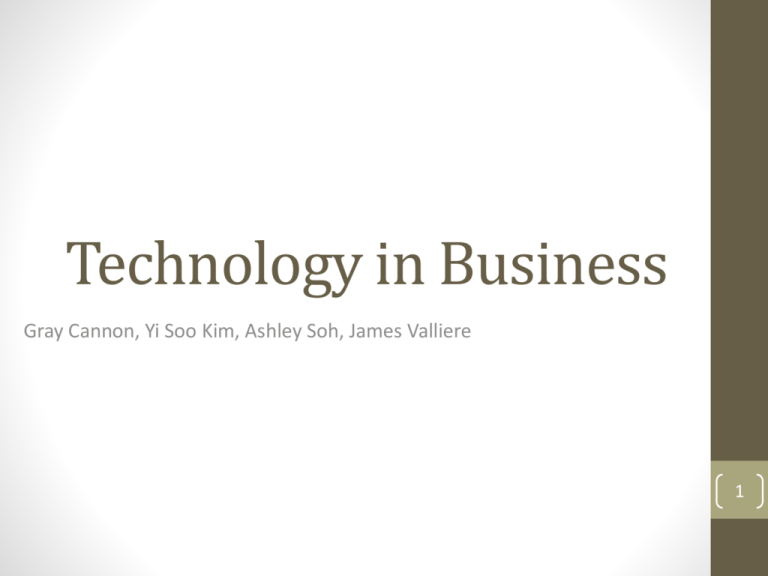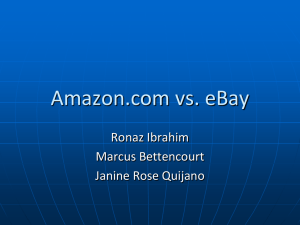Business - the UNC Department of Computer Science
advertisement

Technology in Business Gray Cannon, Yi Soo Kim, Ashley Soh, James Valliere 1 Agenda •Web 2.0 •Target Marketing •Industry Applications •Ethical Concerns 2 •Web 2.0 •Target Marketing •Industry Applications •Ethical Concerns 3 YouTube, Facebook, Myspace vs. eBay, Amazon and Google • Create rich, meaningful user experiences • Allow people to easily locate and collaborate with others of like interest • Support the quick and easy creation of content • Gather, store and leverage large amounts of information to create value 4 Change of Focus • From using the web to deliver information • To creating and delivering robust services • => Web 2.0 • No need to know complicated codes to upload content to the web 5 We are the WEB • http://www.youtube.com/watch?v=6gmP4nk0EOE 6 What is Web 2.0? • We are the Web • Just like Kvetching board • User-generated content • Conversation and information sharing • Aspect of community collaboration • Person of the year in 2006? 7 8 How does it help business? • Tim O’Reilly “the value of the software is proportional to the scale and dynamism of the data it helps to manage” • Wikis – Wikipedia • IBM, Microsoft • Social Networking Tools • MySpace and Facebook 9 Mashups • Uses and combines data, presentation or functionality from two or more sources to create new services. • eBay, Amazon, Google, Windows Live, and Yahoo • Prudential Real Estate • By combining content from its internal real estate listings database and Google Maps 10 11 12 Case Studies • BitTorrent - P2P (peer-to-peer) movement • Rather than downloading a file from a single source, it allows hosts to download and upload from each other simultaneously • The task of distributing the file is shared by those who want it • The service automatically gets better the more people use it 13 14 Internet Businesses • Amazon.com • Sells basically the same products as Barnes&Nobles • But why so successful? • Has made a science of user engagement • order of magnitude more user review, and offer invitations • eBay • acting as an automated intermediary 15 •Web 2.0 •Target Marketing •Industry Applications •Ethical Concerns 16 17 Video http://www.youtube.com/watch?v=9zKXCQpUnMg 18 Target Marketing • Not a new phenomenon • Hundred Million Club (Now the Direct Marketing Club of New York) First use of the term “Direct Marketing” October 1, 1961 in a speech by Lester Wunderman. • Vulnerable Consumers Children, Teens, and Young Adults • Electronic advertisement marketing arena’s • • Present: Television, Mobile Phone, Internet or World Wide Web, Video Games, Electronic Billboards, etc. Future: ? “I am absolutely convinced that the future of our industry lies with… companies which must increasingly bring their selling and marketing influence closer to the consumer. I believe the next ten years will see a continuing decline of the mail-order business as it has been defined in the past. It will be replaced by Direct Marketing – a new and more efficient method of selling, based on scientific advertising principles…” (Lautenslager 3) 19 Target Marketing on the Web • • e-commerce Electronic transactions Data-Mining Algorithms Examples of how data is collected: • • Google Troves Account Data: name, age, gender, e-mail address, and zip code • Gmail, YouTube, Blogger, Picasa, iGoogle, Google Voice, or Calendar Log Data: search history, Google Maps requests, data trackers, etc. Facebook Troves Identity or personal info • Not sold but collected by trackers Privacy • 5,861 words in privacy statement What does this all mean? • Ethical dilemma 20 Internet Marketing Strategies 4. You visit wallstreetjournal.com to read an article on target marketing. The Wall Street Journal has sold space to the ad network so you can view an ad that will entice you to go see the Panthers play Sunday night. You buy the tickets. 2. A tracking company places a code (a cookie) in your computer and logs the sites you visit which identities you as a sports fan. The company can also identify your geographic location and what times of day you visit these sites. 1. You are into sports and visit sports sites often. 3. The Carolina Panthers want to sell football tickets. They request an Internet ad network to entice you into purchasing tickets. 21 •Web 2.0 •Target Marketing •Industry Applications •Ethical Concerns 22 Automotive Industry 1. IBAS (Nissan) What is it ? - A computerized and automated body assembly system - Allows Nissan to build as many as 8 different model on the same assembly line What does it do ? - Has sensors to measure 60 critical dimensions - Builds as many as 40 vehicles in an hour - Nissan can easily shift production of different models among various plants - > flexibility - Uses IBAS software that allows simulation on a computer 23 Digital Plant (Delphi) - 120 automated molding machines but only 18 employees - Digitalizes almost every process– machines, materials, orders and AGV pathways - Controlled by a central computer - Uses software for scheduling optimization - Customers and suppliers are able to “see” into the process 24 RFID Barcodes: Product must be read by the scanner RFID : Can read product as long as it is in the range of a reader : Every product has a unique identity Portable RFID device - Allows to : Manage inventory more efficiently : Reduce data entry error : Products to be received and shipped faster Case Study – Wal-Mart - 16 % reduction in out-of-stocks as well as reduction in excess inventory - Products that used RFID were replenished three times faster - Overall, 63% more effective in replenishing out-of-stocks - Reduced manual order by 10% 25 Airline Industry Digital Fly-By-Wire System - Movement of flight controls is converted to electronic signals - Allows automatic signals sent by the plane’s computers to perform functions without the pilot’s input - Processing is done by digital computers enabling the pilots to fly by computer 26 Airline Industry -Benefits : Reduced pilot’s work-load : Increased safety and reliability : Overall cost reduction : Improved passenger comfort and flying qualities 27 Micropayments PayPal defines micropayments as a transaction of lees than $12. Visa: <$20 Technology allows for small payments to be made with insignificant transaction costs • Apple iTunes Store • eBay seller fees generally amount to a few cents for low-ticket items 28 Contemporary Business Computing • Email is still the most used form of business communication • 2+ hours of a typical workday is not uncommon • Excel is the most commonly used spreadsheet application • Inventory management • Financial projections • Sortable data storage 29 Video • http://www.youtube.com/watch?v=Naf0jxDd-R0 30 •Web 2.0 •Target Marketing •Industry Applications •Ethical Concerns 31 Industrial Espionage What is the difference between “competitive intelligence” and industrial espionage? Potential goals of industrial espionage intellectual property operational information technological surveillance Governments are also targets of industrial espionage 32 Target Industries • Most common in technology-heavy industries • Computer software and hardware • Biotechnology • Aerospace • Telecommunications • Engine technology 33 Agents and Methods of Industrial Espionage • • • • • Dissatisfied employees-> in-office collection Corporate spies-> dumpster diving Hackers-> cyberattacks, malware Hotel workers-> bag-op Governments-> Chengdu J-20 was reverse engineered from F117 Nighthawk “Single greatest threat to U.S. technology” 34 Amazon 1 click Is the technology significant enough to be patented? Is it unethical to make buying so easy and thoughtless? Does it prey on compulsive internet shoppers? 35 Patents • Physical objects • Process, machine or composition of matter • NOT laws of nature, scientific principles, algorithms • Criteria • • • • Novel Not previously described Non-obvious Useful 36 Amazon 1 click Is the technology significant enough to be patented? Is it unethical to make buying so easy and thoughtless? Does it prey on compulsive internet shoppers? 37 Patent or No Patent 38 Ear Wax Mirror 39 Abdominal Support 40 Alcoholic Beverage from Animal Extract 41 No Smoking Ash Tray 42 Toilet Finder 43




